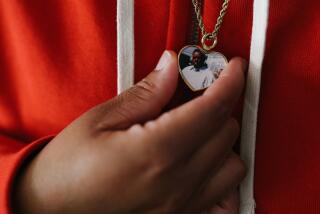Where mentally ill inmates actually get some help
There is little in Andy’s appearance or manner that offers a clue as to what he’s been through. The arrests, the jailhouse beatings, the commitments. He’s soft-spoken and unassuming, so much so that the story of his life doesn’t seem to go with the man who tells it.
I ask how many times he’s been locked up, and now a hint of distress creeps into his eyes.
“Maybe 20,” he shrugs, adding that he’s been in mental institutions nearly as many times.
Andy emailed me after I wrote about a visit to L.A. County Jail, which houses about 3,200 inmates diagnosed with a mental illness. It’s a barbaric system, with many of those inmates repeatedly filing through the turnstiles at great public cost, with little or no chance of getting help that might break the cycle.
“Before 2004, I had spent MANY a time in the L.A. County Jail.” wrote Andy, explaining that he had been diagnosed with bipolar disease. “If you’d ever like some background on surviving … the jails, I’m available. I’ve been stable and productive since 2004, and living in sunny Santa Monica.”
Andy, now 63, grew up in Nebraska. He came west as a young man to attend UC Santa Barbara and later UC Berkeley, where he marched against war and majored in political science while thinking about a career in law or Eastern medicine. But then, when he was about 20, things began to go haywire.
“I would sort of lose my way,” said Andy, who traveled between California and Nebraska without any particular purpose. Simple tasks became unbearable burdens. He couldn’t manage money and felt detached from himself. His worried parents took him to a doctor.
“When I was 25, it was said to be manic depression. I was mostly depressed for five years … then it changed into being characterized by mania.”
Andy’s rap sheet is 10 pages long. He has been accused of burglary, vandalism, trespassing, malicious mischief, arson, battery. Most of the charges were misdemeanors and there is no evidence Andy ever used a weapon other than his fist or his foot, but there were some serious misdeeds that Andy now regrets. He’s been sentenced to jail for as long as a year at a time and in several cases was declared mentally incompetent to stand trial.
In 1977, Andy was arrested in the U.S. Senate building in Washington, charged with arson and sent to a mental hospital for a year.
“I lit a rag and put it out,” said Andy, “and it caused smoke and eventually someone came in and said, ‘What are you doing here?’”
And how did he answer?
“I didn’t even know I was there.”
Andy was put on lithium at the hospital, which helped stabilize him. But there were many times when he refused the medication, lost control and landed back in jail.
“Jail was the worst place ever. It made him worse,” said Andy’s sister Jann. She visited him there on many occasions, often waiting hours for a two-minute chance to let her brother know she loved and supported him. But she was often horrified by his appearance after jailhouse fights.
“He was black and blue all over, with blood on him. He had swastikas written on him with ink pens, all over his skin and uniform.”
Then in 2004, after more than 25 years of struggles, a social worker in the L.A. County Jail tapped Andy on the shoulder.
“She said there was a program called Step Up on Second.”
Andy got into a van, and that short drive from downtown to Santa Monica was the beginning of his dramatic recovery. His treatment at the nonprofit Step Up was made possible by AB 2034, legislation that recognized the connection between mental illness, homelessness and incarceration, and provided funding for full-service therapy, job training and housing.
The intervention made financial sense, too. A year in a California prison costs an estimated $47,000 per inmate. A program like the one Andy entered costs about $17,500 a year, and the evidence of reduced incarceration is irrefutable. But even now, with epidemic prison overcrowding and a staggering number of inmates serving time for crimes related to untreated mental illness, there’s a tragic shortage of slots for programs like the one that helped rescue Andy.
At Step Up, which serves hundreds of clients, Andy got counseling, he switched to a more effective medication and worked as a chef after culinary training. He also moved in with his girlfriend, social worker and therapist Kathy McTaggart. Without McTaggart and Step Up, Andy told me, he might still be in jail or worse.
“I might be dead.”
Andy cared for McTaggart as she battled the cancer that eventually took her life last November. And though he was rocked by the loss, his recovery has continued. He works as a receptionist at Step Up, a job that involves more than a little mentoring and social work, as clients with stories similar to Andy’s call and drop by in need of help.
Andy asked me not to use his last name because he’s worried that his history could be a problem when he looks for another job or applies for housing. But he wanted to tell a story of what’s possible when, rather than punishing people with a mental illness, we help them.
More to Read
Start your day right
Sign up for Essential California for news, features and recommendations from the L.A. Times and beyond in your inbox six days a week.
You may occasionally receive promotional content from the Los Angeles Times.







